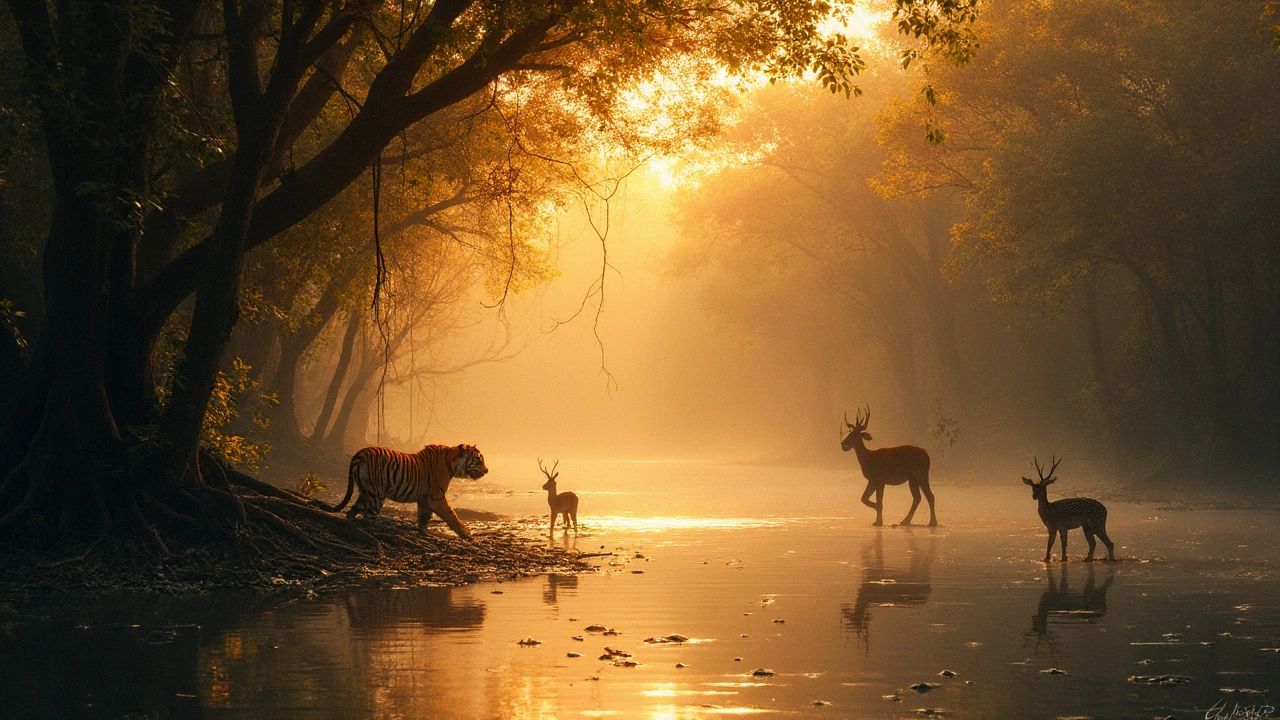Seven Natural Heritage Sites in India: A Quick Guide
 Mar, 27 2025
Mar, 27 2025
So, you're curious about India's natural heritage sites, right? India has some jaw-dropping places—trust me, they're amazing. Picture a land where you can wander through lush rainforests, spot tigers and elephants, and feel the quiet power of ancient mountains. Exactly that! India boasts seven stunning natural heritage sites, each special in its own way.
Ever heard of the Western Ghats? This one's not just about pretty landscapes; it's a biodiversity-hotspot bursting with unique plant and animal life you won't find anywhere else. Or consider the Great Himalayan National Park—imagine breathtaking views and the chance to glimpse rare species, nestled high in the mountains.
Now, if wildlife is your thing, Kaziranga and Keoladeo are must-visits. Home to one-horned rhinos and a riot of birdlife, these places offer unforgettable experiences. And don't forget the Sundarbans, where the elusive Bengal tiger roams the mangroves. Whether you're a nature lover or just looking for some peace, these spots have it all.
- An Introduction to Natural Heritage in India
- The Western Ghats: A Biodiversity Hotspot
- The Great Himalayan National Park: A High-Altitude Wonder
- Kaziranga and Keoladeo: The Wildlife Havens
- Unique Sites: Sundarbans, Manas, and Nanda Devi
An Introduction to Natural Heritage in India
India's natural heritage is like a treasure trove, full of astonishing biodiversity and stunning landscapes. This vast country shelters an incredible array of natural heritage sites that offer a glimpse into nature at its rawest. Whether it's the mystical mountains, dense forests, or intricate networks of rivers and deltas, each region tells its own story.
Take the Western Ghats, for instance. Declared a UNESCO World Heritage site, it's a biodiversity hotspot teeming with rare flora and fauna. Around 5000 species of flowering plants, 139 species of mammals, 508 bird species, and 179 species of amphibians call it home. That's mind-blowing diversity!
Beyond biodiversity, these sites are crucial for conservation. They act as a sanctuary for endangered species, providing the resources they need to survive. The Great Himalayan National Park, for instance, supports several endangered species like the snow leopard and the Himalayan tahr.
Many of these sites are also essential for local communities, offering resources and sustainable livelihoods. The forests and rivers contribute to traditional medicines, tools, and food security for the indigenous tribes.
If you're planning to visit, remember that these places are protected for a reason. They represent our shared natural heritage, and it's up to us to explore them responsibly. A good tip is to stay informed about local guidelines—wildlife isn't just something you watch; it's something you preserve.
| Site | Key Feature |
|---|---|
| Western Ghats | Biodiversity Hotspot |
| Sundarbans | Bengal Tiger Habitat |
So, there you have it—a peek into what makes India's natural sites so unique. Each one is a world of its own, offering not just beauty but vital lessons about nature and conservation.
The Western Ghats: A Biodiversity Hotspot
Alright, let's dive into the vibrant world of the Western Ghats. These mountain ranges stretch nearly 1,600 kilometers through India's west, covering about five states. It's not merely about the stunning backdrop; this place is a biological treasure trove!
Known for its exceptional amount of biodiversity, the Western Ghats are home to an astounding 7,402 species of flowering plants, 139 mammal species, over 500 bird species, 179 amphibian species, and about 6,000 insect species. Plus, a good chunk of these, around 325 globally threatened species, thrive only in these regions!
So why should this matter to you? Well, if you love being amidst nature, trekking, or wildlife photography, there’s no better place. From the misty mountains of Ooty, Munnar's tea plantations, to the lush rainforests of Silent Valley, there's plenty to explore. Each visit supports conservation, which is crucial. These ecosystems play a vital role in regulating weather patterns and ensuring the survival of countless species.
The Western Ghats aren't just some random mountain range—they're a living ecosystem contributing significantly to the air we breathe, the water we drink, and even the climate we experience. Remember, preserving such sites not only maintains their beauty but also ensures a better future for us all.
- For trekkers: Try the Kudremukh trek in Karnataka, it promises exhilarating views.
- Love birds? Don't miss Thattekad Bird Sanctuary in Kerala, home to over 280 bird species.
Statistics show that the Western Ghats contribute 30% of the country's biodiversity. Imagine that! It's like visiting a colorful giant living museum, only it plays a critical part in our survival.

The Great Himalayan National Park: A High-Altitude Wonder
This place is a gem tucked away in the mountains of Himachal Pradesh, and it's every bit as stunning as it sounds. The Great Himalayan National Park covers over 1,170 square kilometers of incredible landscapes. Imagine deep valleys, shimmering glaciers, and peaks that stretch up to the sky. Visiting here feels like stepping into another world entirely.
It's not just the scenery that's awesome—it's also home to loads of rare and endangered species. If you're into wildlife, you'll love this: the park is a sanctuary for animals like the elusive snow leopard, the majestic Himalayan tahr, and even some colorful pheasants that add a splash of color to the green landscape. Birdwatchers and animal lovers, munch on this!
The park is divided into four valleys: Tirthan, Sainj, Jiwa Nal, and Parvati. Each valley offers unique trails for hiking and adventurous treks. Some trails require you to be super fit and prepared, especially if you're planning on tackling the Tirthan valley trek, which can get steep and tricky in places.
For those who love trekking, but not hardcore styles, the Sainj Valley trek is a bit more relaxed, making it perfect for beginners who want to soak up the majestic scenery without wearing themselves out. Remember to carry the essentials like warm clothes and a good pair of boots because, at such altitudes, weather can turn from sunny to snowy in a blink.
- Best months to visit: April to June and September to November.
- Entry Fee: Around ₹100 for Indians and ₹500 for foreigners per day.
- Fun Fact: The park was added to the UNESCO World Heritage list in 2014!
So pack your bags, take a deep breath of the fresh mountain air, and get ready to explore one of India's heritage sites that offers jaw-dropping natural beauty.
Kaziranga and Keoladeo: The Wildlife Havens
Both Kaziranga and Keoladeo encapsulate the heart of India's wildlife majesty, and they're places that every nature enthusiast should have on their radar.
Kaziranga National Park, located in Assam, is practically a household name for anyone who's into wildlife. It's often synonymous with the Indian one-horned rhinoceros, and for good reason. The park holds two-thirds of the world's population of this majestic creature. Imagine spotting these rhinos (from a safe distance, of course) while cruising around the park!
Now, Kaziranga's not just about rhinos. This place is a UNESCO World Heritage Site because it's a thriving ecosystem. From majestic elephants and playful swamp deer to the powerful wild water buffalo, it's teeming with life. And let's not forget the tigers. Though they're a rare sight, knowing they're lurking in the dense forest adds an edge of thrill to the experience.
Switching from lush forests to wetlands, let's talk about the Keoladeo National Park in Rajasthan. Known as a bird-watching paradise, Keoladeo was formerly known as the Bharatpur Bird Sanctuary. It draws bird enthusiasts from all over the globe, especially during the winter months when migratory birds make a stopover, including the rare Siberian Crane.
The park is home to over 370 bird species—no kidding! Some avid birdwatchers say you can spot over 100 species in a single day if you're keen-eyed and patient. Plus, it's relatively small, so you can easily explore it by foot or cycle.
For those planning a visit, here's a quick tip: the best time to visit Kaziranga is from November to April, while Keoladeo is at its bird-watching peak from October to March. So whether you're wild about birds or beasts, these parks really showcase the natural heritage of India in all its glory.

Unique Sites: Sundarbans, Manas, and Nanda Devi
Let's dive into some of India's most unique natural heritage sites that stand out for their unparalleled beauty and significance. First up, the Sundarbans. This magical place is the largest mangrove forest in the world, straddling India and Bangladesh. Forget the usual city noise; here, it's just the whisper of leaves and calls of the wild. The Sundarbans isn’t just about trees—it's home to the majestic Bengal tiger. Think of them as the local celebrities! Spotting one can be tricky but totally worth it for a true thrill.
Heading to the northeast, we find ourselves in Manas National Park. This one’s not just another pretty park—it's a wild hub for species like elephants, rhinos, and golden langurs, to name a few. If you're the adventurous type, river rafting here is a popular vibe. Plus, the park is a haven for bird watchers.
And then there's the serene Nanda Devi, lying in the Garhwal Himalayas. It's not your everyday hill stroll. This park, dominated by the Nanda Devi peak, is more of a trekker's paradise. Think lush valleys, rushing rivers, and snow-clad peaks. And if you're lucky, you might see the rare blue poppy flower here.
- Table of Visitors Statistics
| Site | Annual Visitors (2023) |
|---|---|
| Sundarbans | 200,000 |
| Manas National Park | 30,000 |
| Nanda Devi National Park | 10,000 |
Visiting these sites isn't just about checking places off a list; it's immersing yourself in nature's raw beauty and understanding the importance of preserving these incredible ecosystems. So pack your bags, grab your camera, and make some unforgettable memories!